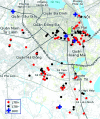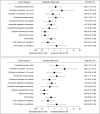Indoor Air Pollution and Susceptibility to Tuberculosis Infection in Urban Vietnamese Children
- PMID: 34343025
- PMCID: PMC8759300
- DOI: 10.1164/rccm.202101-0136OC
Indoor Air Pollution and Susceptibility to Tuberculosis Infection in Urban Vietnamese Children
Abstract
Rationale: The Southeast Asian tuberculosis burden is high, and it remains unclear if urban indoor air pollution in this setting is exacerbating the epidemic. Objectives: To determine the associations of latent tuberculosis with common urban indoor air pollution sources (secondhand smoke, indoor motorcycle emissions, and cooking) in Southeast Asia. Methods: We enrolled child household contacts of patients with microbiologically confirmed active tuberculosis in Vietnam, from July 2017 to December 2019. We tested children for latent tuberculosis and evaluated air pollution exposures with questionnaires and personal aerosol sampling. We tested hypotheses using generalized estimating equations. Measurements and Main Results: We enrolled 72 patients with tuberculosis (27% with cavitary disease) and 109 of their child household contacts. Latent tuberculosis was diagnosed in 58 (53%) household contacts at baseline visit. Children experienced a 2.56-fold increased odds of latent tuberculosis for each additional household member who smoked (95% confidence interval, 1.27-5.16). Odds were highest among children exposed to indoor smokers and children <5 years old exposed to household smokers. Each residential floor above street-level pollution decreased the odds of latent tuberculosis by 36% (adjusted odds ratio, 0.64; 95% confidence interval, 0.42-0.96). Motorcycles parked inside children's homes and cooking with liquid petroleum gas compared with electricity increased the odds of latent tuberculosis, whereas kitchen ventilation decreased the effect, but these findings were not statistically significant. Conclusions: Common urban indoor air pollution sources were associated with increased odds of latent tuberculosis infection in child household contacts of patients with active tuberculosis.
Keywords: built environment; cooking; motorcycles; smoking water pipes; tobacco smoke pollution.
Figures


Comment in
-
Characterization of Air Pollution Exposures as Risk Factors for Tuberculosis Infection.Am J Respir Crit Care Med. 2021 Nov 15;204(10):1130-1131. doi: 10.1164/rccm.202107-1795ED. Am J Respir Crit Care Med. 2021. PMID: 34461027 Free PMC article. No abstract available.
References
-
- WHO. Global tuberculosis report 2020. 2020. [accessed 2020 Dec 01]. Available from: https://www.who.int/teams/global-tuberculosis-programme/data
-
- Rabbani U, Sahito A, Nafees AA, Kazi A, Fatmi Z. Pulmonary tuberculosis is associated with biomass fuel use among rural women in Pakistan: an age- and residence-matched case-control study. Asia Pac J Public Health . 2017;29:211–218. - PubMed
-
- Sumpter C, Chandramohan D. Systematic review and meta-analysis of the associations between indoor air pollution and tuberculosis. Trop Med Int Health . 2013;18:101–108. - PubMed

